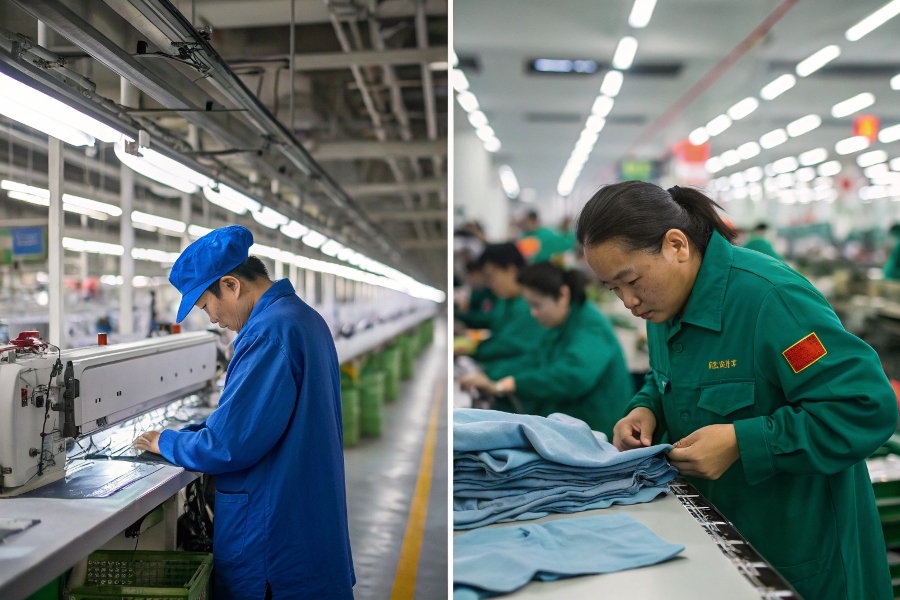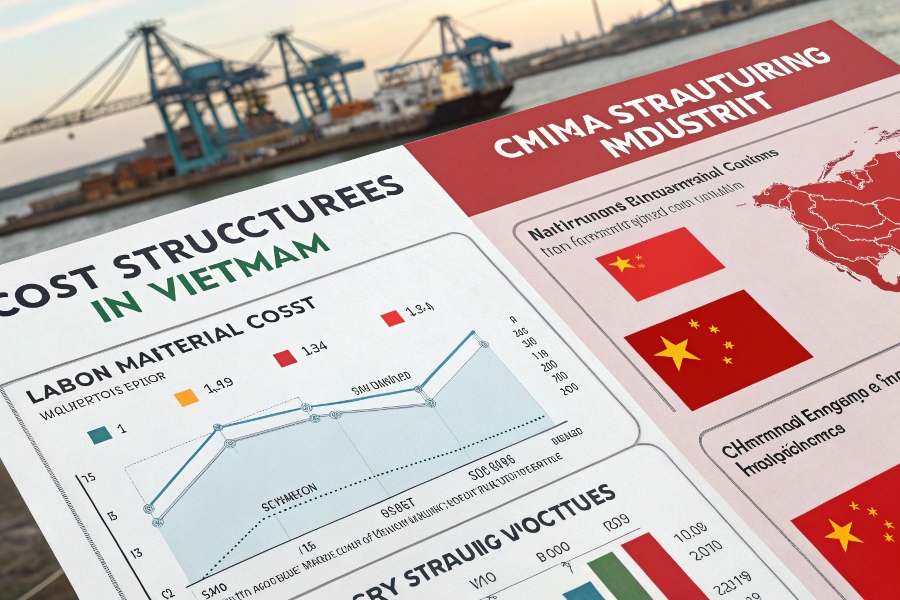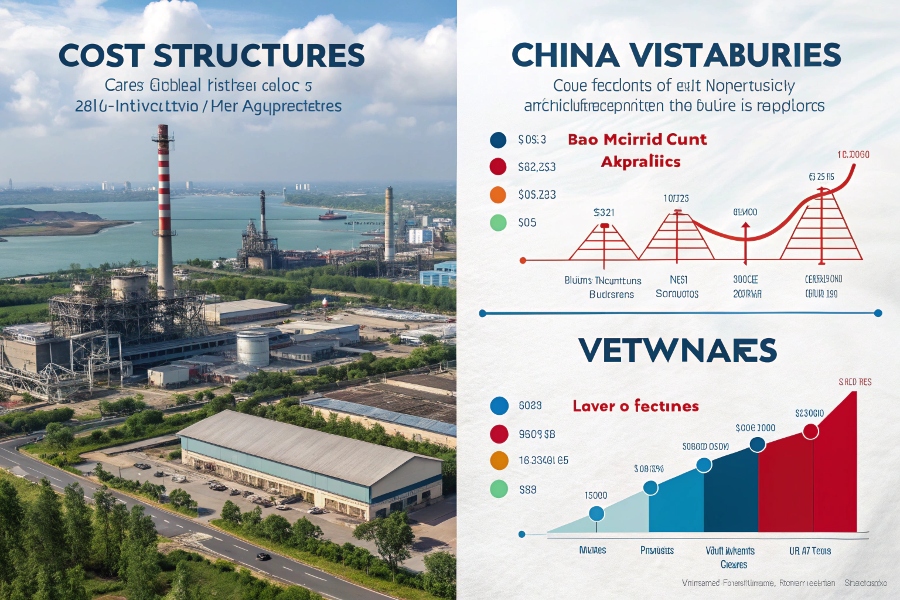Are you sourcing goods from Asia1? Are you considering both China and Vietnam? Do you wonder how factories in these countries compare? You need to understand their similarities and differences.
Having factories in both China and Vietnam has given me a unique perspective. I’ve seen firsthand the strengths and weaknesses of manufacturing in each country. While both offer significant advantages for global sourcing, they are not interchangeable. Understanding the nuances is crucial for making the right decisions for your supply chain.

When I first started sourcing from Vietnam, there were challenges – different infrastructure, a newer workforce in some areas. But there were also clear advantages. It’s a different landscape than China, which has decades of developed manufacturing infrastructure. Recognizing these differences helps you leverage the best of both worlds.
Why Compare Factories in China and Vietnam?
Are you thinking one is just a cheaper version of the other? Are you wondering why you can’t just pick one?
Comparing factories in China and Vietnam is important because they offer different advantages in terms of cost structures, infrastructure, workforce, and specific industry strengths. The right choice depends on your product, volume, and supply chain strategy.

China has long been the "world’s factory," with mature ecosystems for many industries. Vietnam is a rising star, attracting investment due to lower labor costs and favorable trade agreements. What works best for electronics might be different from what works best for textiles. Understanding these differences helps you optimize your sourcing.
Cost Structures
Labor costs, raw material availability, and overheads can differ between the two countries.
| Cost Factor | China Trend | Vietnam Trend |
|---|---|---|
| Labor Cost | Rising | Generally Lower than China’s coast |
| Raw Material Access | Extensive, often readily available locally | Growing, but sometimes relies on imports |
| Land/Facility Cost | Can be high in established areas | Generally Lower |
Historically, labor costs in China were very low, which drove its manufacturing boom. While still competitive, labor costs, especially in coastal regions, have increased. Vietnam generally offers lower labor costs, particularly outside major cities. However, China often has more developed domestic supply chains for raw materials, which can sometimes offset labor cost differences, depending on the product.
Manufacturing Ecosystem and Infrastructure
The maturity and breadth of supporting industries, logistics, and utilities vary.
| Infrastructure Aspect | China Status | Vietnam Status |
|---|---|---|
| Supplier Network | Deep, vast, established for many industries | Developing, stronger in specific sectors |
| Logistics & Ports | Highly developed, extensive | Growing, improving but less extensive |
| Utilities (Power, Water) | Generally reliable, widespread | Improving, but can vary regionally |
| Supporting Industries | Strong across a wide range of products | Strong in textiles, footwear, electronics |
China has spent decades building a massive manufacturing ecosystem. You can often find suppliers for almost any component or process nearby. This makes production faster and more integrated. Vietnam’s ecosystem is less mature but is growing rapidly, particularly in areas like textiles, footwear, and basic electronics assembly. China’s logistics infrastructure (ports, roads, rail) is also generally more developed, though Vietnam is investing heavily.
Workforce Skill and Availability
The skill levels of workers and the availability of specialized labor differ.
| Workforce Aspect | China Status | Vietnam Status |
|---|---|---|
| Skill Level (Overall) | High, especially in complex manufacturing | Growing, strong in assembly |
| Specialized Skills | Deep expertise in various niches | Developing, often trained for specific tasks |
| Labor Availability | Varies by region and industry | Generally good, younger workforce |
China has a large pool of experienced workers and engineers, capable of complex and high-precision manufacturing. Vietnam has a younger workforce that is generally skilled in assembly line work and is quickly gaining expertise. For highly technical or specialized products, China might still have the edge in terms of readily available skilled labor and engineering support.
Specific Industry Strengths
Certain industries or product types have more established and competitive manufacturing bases in one country over the other.
| Industry/Product | China Strength | Vietnam Strength |
|---|---|---|
| Electronics (Advanced) | Strong, complex components, R&D capacity | Strong in assembly, some components |
| Textiles & Apparel | Still large, but facing cost pressure | Very Strong, major export hub |
| Footwear | Large production capacity | Very Strong, major export hub |
| Furniture | Significant production | Growing |
| Basic Components | Wide variety, high volume | Growing, some specific types |
China remains dominant in complex electronics, machinery, and a vast range of components due to its deep supply chain. Vietnam is a global leader in textiles, apparel, and footwear, benefiting from lower labor costs and favorable trade agreements. For some products, the decision might come down to which country has a more specialized and efficient industry cluster.
What are the Manufacturing Advantages of Each Country?
Are you trying to weigh the pros and cons? What specific benefits does each offer?
Both China and Vietnam offer significant manufacturing advantages, but they cater to different needs. China excels in scale, complexity, and a mature ecosystem, while Vietnam offers cost competitiveness and advantages for certain product types.

Choosing the right location depends on your specific requirements, including product type, volume, required technology, and desired cost structure. Sometimes, using both locations for different parts of your supply chain can be the optimal strategy.
China’s Manufacturing Advantages
China offers unparalleled scale, a deep and broad supply chain, and significant technological capabilities.
| Advantage | Benefit |
|---|---|
| Scale and Capacity | Can handle massive production volumes |
| Comprehensive Ecosystem | Easy access to components and services |
| Technological Capability | Expertise in complex and high-tech products |
| Speed and Flexibility | Rapid prototyping and production changes |
| Established Infrastructure | Efficient logistics and support services |
If you need very high volumes, complex products, rapid prototyping, or access to a wide range of specialized components and services, China is often the go-to. The sheer scale of its manufacturing base and supporting industries is unmatched. It’s like a one-stop shop for many types of manufacturing.
Vietnam’s Manufacturing Advantages
Vietnam offers competitive labor costs, a growing infrastructure, favorable trade deals, and specialization in certain industries.
| Advantage | Benefit |
|---|---|
| Lower Labor Costs | More cost-effective for labor-intensive goods |
| Favorable Trade Agreements | Reduced tariffs for export to certain markets |
| Growing Infrastructure | Improving logistics and industrial zones |
| Specialization | Strong expertise in textiles, footwear, etc. |
| Diversification Option | Reduces reliance solely on China |
For labor-intensive products like apparel or footwear, or if you are exporting to markets that have preferential trade agreements with Vietnam (like the EU or some ASEAN countries), Vietnam offers a strong advantage. It’s also an excellent option for companies looking to diversify their sourcing away from China.
Conclusion
Chinese factories offer scale, a deep ecosystem, and technological strength, while Vietnamese factories provide cost competitiveness, trade advantages, and specific industry focus. The best choice depends on your product and supply chain needs.
-
Learn effective strategies for sourcing goods from Asia, ensuring you make informed decisions for your supply chain. ↩
